
The Via Consolare Project in Pompeii
 |
||||||||
|
The Via Consolare Project in Pompeii
| ||||||||
| Home | Research | Internships | Team | Links | Contact | |||
| Summary | 2005/2006 | 2007 | 2008 | 2009 | 2010 | 2011 | 2012 | 2013 | 2014 | 2015 | 2016 | 2017 | 2018 | VCP 3D |
| 2019 |
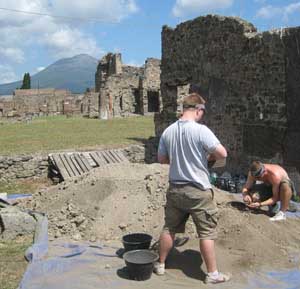
Screening underway during 2009. |
Field Season 2009 Between the 24th of June and the 4th of August 2009, with the ongoing permission of the Soprintendenza Archeologica di Napoli e Pompei and with the kind support of Professore Guzzo and Dottore D’Ambrosio, the members of the Via Consolare Project continued research and produced a wealth of important information relating to the historical development and excavation histories of both Insula VII 6 and the Villa delle Colonne a mosaico. Expansion of our test trench from 2008 produced more details on the final occupation phases of the tabernae situated at Insula VII 6, 26-27, including the precise condition of these shops at the time of the eruption and the nature of a comprehensive programme of restoration and refurbishment that was in progress during the last days of the city’s life. Our excavations in the Villa delle Colonne a mosaico clarified important and previously poorly-documented information on the precise disposition of early ‘Samnite-Oscan’ graves, presumably uncovered in the pre-war campaigns of A. Maiuri in the viridarium and sacellum of the Villa. The Via Consolare Project also continued recording and documentation for our 3-D spatial database. Primary topographic survey was completed in Insula VII 6 including important underground portions of the settling tank of the Terme del Foro and its access corridors and 3-D recording continued in the Villa delle Colonne a mosaico including the viridarium and sacellum. In both areas, wall sequence analysis continued as in previous years. Each of the sections below gives greater detail to the particular components of our research season. |
|
Excavation of VII 6. 26.27 - AA 1
In 2009, the Via Consolare Project continued excavation in the area of Regio VII insula 6 doorways 26 and 27 in order to elucidate the nature of the ancient activity identified in the 2008 season. What had appeared as a cistern collapse in 2008 was revealed to be a system of channels and holes likely intended to provide an extensive new drainage system to the area. These works appear to have been interrupted directly by the AD 79 eruption itself, and from our excavations it is possible to restore not only the working positions of the individual diggers, but also the locations of their spoil heaps. This provides an important window onto not only the condition of this part of the city at that particular moment, but also provides further evidence on the types of building activities which were underway during the seventeen years between the earthquake of AD 62 and the eruption. This activity is especially significant because the large-scale nature of these changes not only would have influenced traffic patterns on the Vico dei Soprastanti but might also be characterised as ‘municipal’ in terms of scale. Moreover, our excavations in Insula VII.6 successfully documented a complicated sequence of development prior to that moment, including the building of the Casa di Secundus Tyrannus Fortunatus over and against the remains of an earlier masonry structure, several sequences of related drains, the refurbishment of the area with a series of tufo facades creating the final disposition of shop fronts visible today, and even some information on the activities going on the shops during their final two phases. The phases identified via excavation were, briefly, as follows: Phase 1 – Early deposits The earliest deposits in the area were cut into the natural soils and consisted of a few small pit cuts. Whilst the nature and use of these cuts is not yet known since they were themselves truncated by later levelling actions, it is hoped that continued excavation in 2010 will reveal more about these features. Phase 2 – Primary spatial division The first significant masonry building activity in the area was the construction of a north-south wall over a shallow foundation deposit, terminating at a T-junction with a large Sarno stone block at the south end defining the east and west rooms. Possibly, this wall connected with a now-absent southern wall, or represented one side of a shop that was open on this side. A drain was placed along the west side of this wall during this phase, draining water or other fluids from the north to the south and out onto the street. Phase 3 – Casa di Secundus Tyrannus Fortunatus As a part of the primary creation of the house, a south wall with significant foundation for a now-missing Sarno stone south wall (two blocks are still in evidence atop the black lava footing) was created in this phase. A large black lava opus incertum corner block and wall at the north side of the room were built in order to define the room, cutting through the construction of the drain at the north end and terminating its use at its southern end. The eastern room was also defined at this point with a large Sarno stone block atop a significant foundation with a Sarno stone opus incertum wall running north. During this time, the west room must have been oriented to the north or west, communicating with the rest of the Secundus Tyrannus property, possibly necessitating a higher floor level. Phase 4 – Nocera Tufo phase shops At some point thereafter (precise dating awaits completion of pottery analysis, but probably in the mid to late 2nd c. BC), both east and west rooms seem to have been reoriented to face south, along with the rest of the southwest corner, having been converted into shops with Nocera tufo frontages. Large blocks of tufo were levered into place atop the Sarno stone blocks, leaving the north-south wall largely intact. The reorientation of the rooms required a significant drop in floor level to meet the level of Vico dei Soprastanti, and soil was removed from the area at this time, resulting in late features cutting into much early deposits. The southern wall was also removed at this stage to allow for the placement of a southern threshold, though this was itself removed during final phase works (cf. infra). It is likely that there were earthen floors across both areas when they were in use, which do not survive in the western room, but are present in the eastern room. A late-phase drain ran through the eastern room draining from the north to the south. A large amount of glass and glass-working debris in one deposit suggests that this room may have once functioned as a glass working shop, but further evidence and analysis of the glass will be necessary to strengthen this conclusion. Phase 5 – Construction work As mentioned above, perhaps the most interesting aspect of the AA was the large-scale construction work that seems to have been taking placed during the final moments of the city’s occupation. Three large, nearly two-metre deep, trenches, a size accommodating the shoulder width of a man, had been cut through the floors of both shops, possibly for the construction of a drainage system that was never completed. Pick marks from the creation of the trenches were still evident in the bases of each. Additionally, the sidewalk had been excavated along the length of the curb-stones in front of doorways 26 and 27. Phase 6 – Eruption It seems likely that the construction work may have been ongoing during the early stages of the eruption itself since there was a layer of trampled soils that were mixed in with lapilli in each trench. These trenches were then filled by material that slumped in from the spoil heaps present nearby. The original curb stones had been severely undercut by the work along their edge and collapsed into the trench during the eruption, such that they were found with lapilli both under and above them. Phase 7 – Modern When the area was first excavated, it seems to have undergone only cursory removal of eruption deposits, such that the working trenches that were open in AD 79 were left largely untouched. At some point later, large Sarno-stone blocks were placed along the street to replace the stones that had collapsed into the trench cut along their northern side. Given that many of these stones appear to derive ultimately from the primary build of Casa di Secundus Tyrannus Fortunatus, it is probable that this occurred after the Allied bombing of the area during WWII, when these stones would have been available for reconstruction efforts. Additionally, a tufo block atop an ancient base has been re-erected (incorrectly) in the modern period. Finally, the most recent change in the area was the cutting of a shallow trench along the northern side of the paving stones for the placement of modern electrical wiring. |
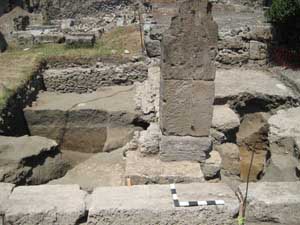
Excavation in Insula VII 6 during 2009. 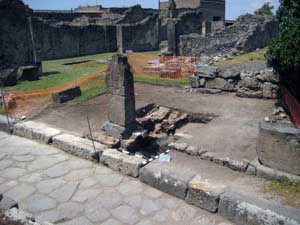
Extent of the area of the 2009 trench. 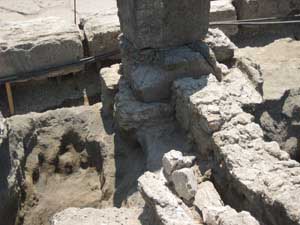
Sarno wall running north/south to meet a Sarno stone block at the shop frontage. 
Black lava opus incertum build supported by a significant wall foundation (post excavation). 
Pick marks visible in the base of one of the trench cuts. |
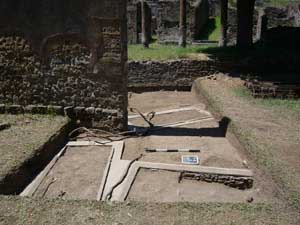
2009 excavation in AA 4, uncovering inhumation graves (modern consolidated). 
Semicircular cut within the northern sondage. 
Clean of the stairs in the Villa delle colonne a mosaico. 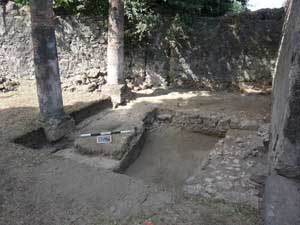
Extent of AA 5 in the Villa delle colonne a Mosaico. |
Excavation in the Villa delle Colonne a mosaico – AA 4
Two years ago, the Via Consolare Project selected several areas for geophysical survey in the Villa delle Colonne a mosaico, primarily to determine the presence or absence of subsurface features and intact stratified deposits within this part of the ancient city. Geophysical results showing at least three subsurface features guided the placement of Archaeological Area 4 (AA 4) within the walls of the viridarium and extending from the southern face of a shallow retaining wall. Here it was hoped to determine the extent and function of these features and at the same time to recover artefacts useful for the dating of selected wall sequences in the Villa delle Colonne a mosaico. Extensive modern deposits were removed from the area, revealing three heavily reconstructed, irregularly-aligned inhumation cist-graves. It is likely that these constructions are the result of the excavations of A. Maiuri in the 1930-40’s and were a component of his preparations of the Villa for general display that included replanting the viridarium and running water to the nymphaeum. In order to determine the maximum depth of Maiuri’s excavations, a one-meter wide sondage was excavated along the northernmost edge of the trench. Located ca. 40cm below the surface level of his backfill in this northern sondage, a curvilinear cut into ‘natural’ deposits was uncovered which represents some of the earliest activity in the area (and which was not recovered by Maiuri’s own investigations). Filling this deep cut (ca. 70cm) was a deposit of very dark brown/black silty-sand, that sadly was devoid of datable material. The excavation of the sondage also revealed that the northern retaining wall present in the sacellum of the Villa is an entirely modern addition to the area. AD 79 Level Cleaning of Stairs in Villa delle Colonne a mosaico The most important aspect of the excavation of AA 4 was the uncovering of a ‘natural’ sequence of soils located near the staircase on the western side of the sacellum. While there was no floor surface found in association with the stairs, the stairs appeared to be built upon the deposit of grey-coloured sand. The presence of the modern overburden running partially beneath the stairs obscured the direct relationship between the build of the stairs and this deposit, but overall the footing of the wall and the foundation of the stairs seem to have been cut into the ‘natural’ sequence of soils. Importantly, this sequence of ‘natural’ soils is present at a much higher elevation than that of the current ground level throughout much of the rest of the area. This implies that the ancient floor level of the Villa was actually higher than that present today and may help to reconcile the differences in elevations found throughout the entirety of the Villa delle Colonne a mosaico, including the northern retaining wall. It is also interesting to note that the walls of the viridarium are built into a natural sequence. It may further be deduced that the Villa is the first structure built in this area after the ‘Samnite-Oscan’ graves. Excavation in the Villa delle Colonne a mosaico – AA 5 This year we also excavated an area in the north-western corner of the colonnaded area in the southern extent of the main Villa buildings. This was in order to establish both reliable evidence pertaining to the sequencing and dating of the walls in this location, and to understand the development and function of this exterior space. Since excavation of this area did not begin until well into the field season, only the modern deposits were excavated completely. As in AA 4, excavation revealed evidence of previous excavations, which once again may be attributed to the activities of Maiuri. These interventions were quickly identified and removed, revealing a number of primary earthen deposits relating to the final uses of the Villa and its spatial disposition. Such preservation is especially remarkable given the number of years during which the Villa has been exposed since its original excavation and the amount of plant growth that has taken place subsequently. Perhaps the most notable feature recorded was a low lava opus incertum wall, which extended from the northern face of the western-most column to meet the north wall in a T-junction and formed the western boundary of Maiuri’s trench. While the northern two-thirds of the wall was perhaps re-constructed as a retaining wall, it is probable that the section of wall against the western-most column is of ancient construction, a conclusion strengthened by the presence of ancient lead water pipe. Running against the western and southern walls are hard-packed earthen surfaces, which likely represent the floors in use during the final phases of the Villa’s occupation, and promise well-preserved stratified deposits a lower levels. Further understanding of these surfaces as well as a detailed stratigraphic history of the area must await further excavation in 2010. |
|
Artefacts During the 2009 field season we practiced 100% recovery of stratified artefacts, screening all excavated ancient material through 1 cm mesh. All materials were bagged and labelled at trench-side. After each soil deposit (stratigraphic unit) had been excavated completely, all artefacts recovered were cleaned and accessioned into our inventory records system. The artefacts recovered were processed individually by material for accessioning and storage. Pottery and ceramic materials were washed gently in order to remove excess soil, then dried and bagged. Bone was also washed and examined for butchery marks or other details. Delicate finds such as metals and glass await conservation and cleaning by specialists. Pottery Analysis Primary sorting and analysis of pottery for the VCP began this year such that all pottery from the 2008 season and approximately 60% of the pottery from the 2009 season was sorted and recorded. During the sorting process, it became apparent that some sherds present in AA1 represent a very late date range for Pompeii, and are associated with deposits identified during excavation as belonging to the final phases of the city. Comprehensive dating will be performed on the pottery during the 2010 season to solidify each AA’s sequence and chronology both in VII, 6 and the Villa delle Colonne a mosaico. Ecofacts In addition to the materials recovered through excavation and screening, a sample from each ancient deposit was put through the process of archaeological floatation in order to be able to find smaller and more fragile ecological materials that might not have otherwise been recovered. By the process of ‘bucket flotation,’ ecofactual remains were recovered by manual agitation and screening. A percentage of the heavier fraction was sorted daily and finds recovered included considerable amounts of marine and terrestrial shell, mammal and fish bones and charcoal. Perhaps unsurprisingly, the largely modern deposits of AA 4 lacked all ecofactual material, while AA 1 produced several deposits of significant interest. Particularly rich in ecological materials was a soft yellow deposit on top of what was interpreted as a primary working surface. This deposit included a considerable amount of fish and mammal bones, charcoal, fish scales, seeds, marine and terrestrial shells, and tentatively-identified coprolite material. Wall Phasing/Analysis in the Area of the Villa delle Colonne a mosaico Walls analysis during the 2009 season built on the work carried out in 2008 in the shops surrounding the Villa della Colonne a Mosaico. This analysis centred on the two shops south of the Villa and the walls delimiting the viridarium of the house in order to relate the construction in this area to the shops north of the Villa analysed in 2008. The earliest phase of building identified was a few courses of black lava opus incertum construction visible at the base of the southern part of the western wall of the viridarium, possibly relating to an early delimitation of this space. The second major phase of building involved the construction of walls delimiting the two shops and the fauces and viridarium of the house, in several distinct periods of construction. All of the shops had very similar plaster with a red/pink lower range of the ground floor and a white plaster higher on the walls and there was also evidence of plaster on the second floor level. All walls analysed showed evidence of historic and modern reconstruction. There was also evidence of a ‘robber’s hole’ between the southernmost shop and the viridarium, which has subsequently been filled with a Bourbon-period reconstruction. The shops south of the Villa mirror the construction history of the shops north of the Villa indicating that the whole area seems to have been built in one event as a single concept that both defined the shops running along the Via Consolare and created the fauces and the viridarium of the Villa. Only the alignment of the western wall of the viridarium itself may have been influenced by an earlier construction in this area, but excavation will be necessary to prove or disprove this hypothesis. Total Station Survey This year we continued the process of completing the accurate 3D model of the standing remains of both areas under our examination. We focused on completing the final few areas of the insula that had not previously been surveyed, specifically the peristyle and surrounding rooms in Casa di Petutius Quintio, and the Forum Baths settling tank. Survey work also commenced in the interior of the Villa delle Colonne a mosaico in order to add to the work completed on the shops lining the exterior. We completed the fauces and viridarium as well as the complicated nymphaeum, which is set into the eastern wall of the viridarium. We then moved into the peristyle area, towards the series of utilitarian rooms in the villa, areas that, in addition to the shops, will form a major focus next season. During this season, we also continued to test the Total Station as not only a tool for recording the extensive standing remains of VII.6 and the Villa delle Colonne a mosaico, but as an essential tool for recording our areas of excavation. The trench extents and baselines of all three of our trenches this year (AA 1, AA 4, and AA 5) were recorded and incorporated into the 3D model. In addition, the Total Station was used to record deposits, features, and section plans that would have been difficult or impossible to record manually. This practice will have many practical and useful applications beyond aiding the one-dimensional planning and drawing of the excavation areas for the Via Consolare Project. These recorded areas will be added to the 3D model and will allow an even more extensive and accurate picture of the areas under examination, not only at the time of the AD 79 eruption, but also the periods of construction activity beforehand. Water Tower Access Corridor Cleaning and Survey The survey of the Forum Baths’ water tower was one important contribution to the completion of the VII 6 model after an extensive cleaning of this area. With the great assistance of Giuseppe and Gennaro Di Martino, members of the team were granted entrance to the access corridor and the subterranean service room of the water settling tank associated with the Forum Baths. Modern debris was removed to enable accurate topographical survey of the stairwell as well as the service room below. Removal of the modern overburden revealed a well-preserved tile stairway, as well as the intact packed earth floor of a subterranean service room and an incompletely excavated service passage approximately 2 metres below the street level of Vico di Terme. The completion of these areas concluded our survey of Insula VII 6. Conclusions Overall, the work of the Via Consolare Project this year has provided a wealth of important information about the building history and socio-economic development of the course of the Via Consolare, but has also raised a number of important new questions and highlighted areas that must be investigated further in future field seasons. In the summer of 2010 we will return to our trenches in Insula VII 6 and the Villa delle Colonne a mosaico in order to complete their excavation and to examine further the wider relationships of these important areas. As always we remain deeply indebted to the Soprintendenza Archeologica di Pompei, the Direzione, Professore Guzzo and Dottore D’Ambrosio and thank them for their kind and continued support and encouragement in our research activities. |

Terracotta oil lamp. 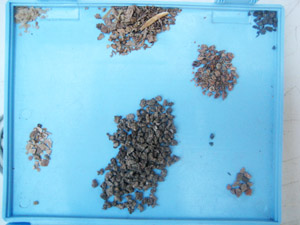
Ecofacts from rich archaeological deposit. 
Pottery sorting underway. 
Wall analysis in the shops outside the Villa. 
Surveying within the excavated trench. 
Doorways to the watertower access corridors. |
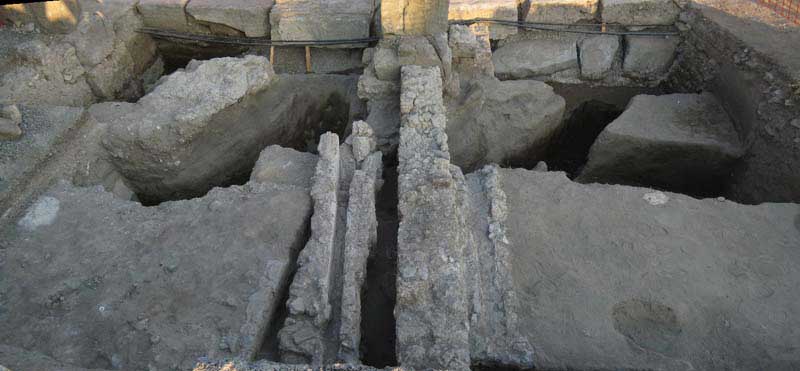 |
|
|
||||||||
|
Website Content © Copyright Via Consolare Project 2018
| ||||||||